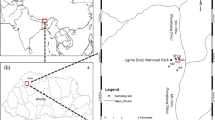Abstract
Plant communities were sampled in the lower reaches of the Tarim River, Xinjiang. The results showed that there are 23 species belonging to 21 genera in 11 families, most of which have low occurrence frequency in quadrats. The most common species isTamarix ramosissima, which occurred in 17 sites accounting for 89.47% of the total 19 sites. Quantitative classification (TWINSPAN) and ordination (CCA) methods were used to study the distribution patterns of 23 plant species in 19 sites in this valley. TWINSPAN results showed that the plant communities in the middle reaches of the Tarim River could be divided into 3 groups and the sampling sites could be divided into 7 types in 3 groups. CCA results were consistent with TWINSPAN results, and showed species distribution patterns correlated with major environmental variables of groundwater level and soil moisture.
Similar content being viewed by others
References
Gittins R T, 1985. Canonical Analysis: A Review with Applications in Ecology. Berlin.
Hill M O, 1979. TWINSPEN: A Fortram for Arranging Multivariate Data in an Ordered Two-way Table by Classification of the Individuals and Attributes. Ithaca, New York: Cornell University.
Jiang Hong, Huang Jianhuiet al., 1994. Study on ordination, quantitative classification and environmental interpretation of plant communities in Dongling Mountain.Acta Botanica Sinica, 36(7): 539–551. (in Chinese)
Liu Qing, Zhou Lihua, 1996. Primary study on interrelation between plant communities and environmental factors in the north shore of Qinghai Lake.Acta Botanica Sinica, 38(11): 887–894. (in Chinese)
Liu Yanliang, 2000. Report on Field Survey of Middle and Lower Reaches of Tarim River. Beijing: China Statistics Press, 22–23. (in Chinese)
Ter Braak C J F, 1986. Canonical correspondence analysis: a new eigenvector method for multivariate director gradient analysis.Ecology, 1986, 67: 1167–1179.
Tongway D J, Ludwig J A, 1994. Small-scale patch heterogeneity in semi-arid landscapes.Pacific Conservation Biology, 1: 201–208.
Wang Xiaoan, 1997. Multivariate analysis of desert in Anxi.Acta Botanica Sinica, 39(5): 461–466. (in Chinese)
Whittaker R H, 1952. A study of summer foliage insect communities in the Great Smoky Mountains.Eco. Monogr., 22(1): 1–4.
Whittaker R H, 1956. Vegetation of the Great Smoky Mountains.Eco. Monogr., 26(1): 1–80.
Wupuerjiang T, 1999. Preliminary approaching to ecological environment problem of middle and lower reaches of Tarim River.Environmental Protection of Xinjiang, 21(1): 34–39. (in Chinese)
Xu Yinqing, Hu Yukun, Ma Yinhua, 2001. Influence on ecological environment exerted by regional development and countermeasures for restoring ecological environment in the lower reaches of Tarim River.Arid Land Geography, 24(4): 342–346.
Zhang Yuanming, Cao Tong, Pan Borong, 2002. Quantitative classification and ordination analysis on bryophyte vegetation in Bogda Mountain, Xinjiang.Acta Phytoecologica Sinica, 26(1): 10–16. (in Chinese)
Author information
Authors and Affiliations
Rights and permissions
About this article
Cite this article
Yuanming, Z., Yaning, C. & Daoyuan, Z. Quantitative classification and analysis on plant communities in the middle reaches of the Tarim River. J. Geogr. Sci. 13, 225–232 (2003). https://doi.org/10.1007/BF02837462
Accepted:
Issue Date:
DOI: https://doi.org/10.1007/BF02837462




